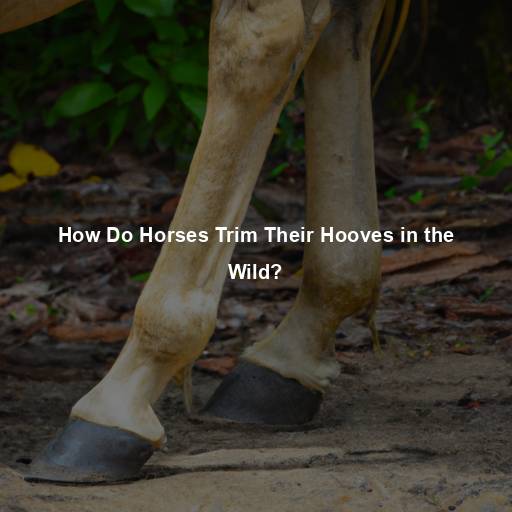Which Horses are Used for Riding?
Last Updated on November 22, 2023 by Evan
Contents
- 1 Understanding the Different Types of Riding Horses
- 2 The Importance of Matching the Right Horse to the Rider
- 3 FAQs: Which Horses are Used for Riding
- 3.1 What breeds of horses are commonly used for riding?
- 3.2 Can any horse be used for riding?
- 3.3 What makes a horse suitable for riding?
- 3.4 Are certain horses better for specific types of riding?
- 3.5 Can ponies be used for riding?
- 3.6 Do horses used for riding require any special training?
- 3.7 Can older horses still be used for riding?
Understanding the Different Types of Riding Horses
When it comes to horses, they have been our loyal companions for centuries. From their majestic presence to their incredible strength, horses have played a vital role in human history. One of the primary purposes of horses is riding, and they have been selectively bred for various riding disciplines. In this article, we will explore the different types of horses used for riding and delve into their characteristics, temperament, and suitability for specific equestrian activities.
Thoroughbred Horses
When it comes to the world of equine excellence, few can compare to the awe-inspiring Thoroughbred horses. With a legacy rooted in the pursuit of speed and grace, these majestic creatures captivate our hearts with their slender frames, sculpted muscles, and boundless vitality. From the racetrack to the competitive arenas of show jumping, dressage, and eventing, Thoroughbreds flaunt their innate athleticism with a fervor that leaves us breathless. Their unwavering spirit and unwavering dedication to their riders have solidified their position as the beloved companions of skilled equestrians worldwide.
Quarter Horses
Quarter Horses are widely recognized as one of the most versatile breeds in the world. Their strong build, muscular hindquarters, and low center of gravity make them well-suited for activities that require quick bursts of speed and agility. Originally bred for working on ranches and herding cattle, Quarter Horses are highly proficient in western riding disciplines such as reining, cutting, and barrel racing. Their calm and gentle demeanor also makes them suitable for novice riders.
Arabian Horses
Arabian horses are known for their elegance, endurance, and distinctive head shape. Originating from the Arabian Peninsula, these horses have been selectively bred for thousands of years. Arabian horses possess incredible stamina, making them ideal for long-distance riding disciplines such as endurance riding and trail riding. Their intelligence, sensitivity, and strong bond with their riders make them a favorite among experienced equestrians.
Warmblood Horses
Warmblood horses are a popular choice for competitive sports such as show jumping, dressage, and eventing. These horses are a crossbreed between hot-blooded and cold-blooded horses, combining the athleticism and agility of Thoroughbreds with the calm and steady temperament of draft breeds. Warmbloods are often sought after for their excellent movement, trainability, and versatility in various equestrian disciplines.
Appaloosa Horses
It’s a bewitchingly vibrant world where the enchanting Appaloosa horses reign supreme. Their kaleidoscopic coat patterns dance from spotted marvels to resolute solids, leaving onlookers captivated and perplexed. Reverberating through the annals of time, these majestic creatures have been cherished by Native American tribes, lauded for their unyielding versatility, unshakeable endurance, and unparalleled intelligence. Whether it’s the untamed Wild West or the refined world of English disciplines such as dressage and show jumping, Appaloosas effortlessly embrace the challenges, their sturdy splendor and agile finesse accommodating riders of all walks, conjuring an exhilarating rendezvous like no other.
Andalusian Horses
Andalusian horses, also known as Pure Spanish Horses, have a long and storied history. Originating from the Iberian Peninsula, these horses are celebrated for their beauty, grace, and strong presence. Andalusians are highly versatile and have been used for both riding and driving. Their natural collection, agility, and willingness to please make them well-suited for classical dressage and working equitation.
Mustangs
Mustangs are wild horses that roam freely in various regions of North America. These horses have a strong sense of survival and adaptability, making them hardy and sure-footed. Mustangs possess a natural athleticism and are known for their endurance and agility. While they may require experienced riders due to their independent nature, Mustangs can excel in a variety of riding disciplines such as trail riding, endurance riding, and even western performance events.
Friesian Horses
Friesian horses are renowned for their striking appearance, with their long, flowing manes and tails. Originating from the Netherlands, these horses have a rich history in both riding and driving. Friesians are known for their elegant movement, making them a popular choice for dressage and carriage driving. Their gentle nature and willingness to work also make them suitable for recreational riding and pleasure driving.
The Importance of Matching the Right Horse to the Rider
When it comes to horse riding, finding the perfect equine companion is paramount for both comfort and safety. From elegant thoroughbreds to sturdy quarter horses, the equine world offers a dazzling array of choices. But fret not, as our experts have curated a comprehensive guide to unravel the enigmatic realm of riding horses. Delve into the labyrinthine world of equine personalities, decipher the intricate tapestry of temperaments, and discover the horse that aligns seamlessly with your equestrian aspirations.
Riders with limited experience or beginners may benefit from riding horses known for their calm and gentle temperament, such as Quarter Horses or certain Arabian bloodlines. These horses can provide a solid foundation for learning riding skills and building confidence in the saddle.
Experienced riders, on the other hand, may prefer horses with more energy and athleticism, such as Thoroughbreds or Warmbloods. These horses can handle the demands of competitive riding disciplines and offer the thrill of higher levels of performance.
It is also important to consider the rider’s physical attributes and riding style when choosing a horse. Factors such as height, weight, and riding goals can influence the suitability of a particular horse.
As equestrians, we know that the horse-rider relationship is a pivotal aspect of our passion. The intricate dance between these two beings is a magical saga of trust, communication, and synchronicity, igniting a profound emotional bond that transcends words. Through this profound connection, our equestrian journeys are elevated to new heights, unveiling a captivating world of harmony between rider and steed.
Training Methods and Techniques
When it comes to the art of training horses for the noble sport of riding, a fascinating tapestry of communication and trust weaves itself between these majestic creatures and their human counterparts. Equestrians, those tireless custodians of equine prowess, employ a myriad of distinct methods and techniques, each with its own enigmatic philosophy and unique approach. Discover the captivating world of horse training as we delve into a few of the most commonly practiced techniques that add an element of mystery and intrigue to this timeless pursuit.
Natural Horsemanship
When it comes to horse training, natural horsemanship takes the reins. This approach places a premium on comprehending the equine’s inherent instincts and behaviors. By forging a bond built upon trust, respect, and open lines of communication, natural horsemanship seeks to create a harmonious partnership. Achieved through a combination of groundwork exercises, desensitization strategies, and progressive training methods, this style of horsemanship lays the groundwork for success.
Classical Dressage
Step into the enchanting world of classical dressage, where the artistry of horsemanship intertwines with grace and discipline. It is a realm where balance becomes a delicate dance, flexibility unlocks hidden potential, and obedience transforms into a harmonious partnership. Through meticulously crafted movements and exercises, horses transcend their physical limitations, embracing a state of sublime finesse and mental clarity. The pursuit of classical dressage not only cultivates lightness and harmony but also kindles within the horse a fiery passion to perform with unwavering enthusiasm.
Western Training Methods
Western training methods, often associated with disciplines such as reining and cutting, prioritize a horse’s responsiveness to cues and the development of specific skills. These methods focus on teaching horses to maneuver with agility, stop, turn, and perform other maneuvers required for western riding disciplines.
Positive Reinforcement Training
Positive reinforcement training utilizes rewards such as treats, praise, and clicker training to reinforce desired behaviors in horses. This method focuses on creating a positive and enjoyable learning experience for the horse, promoting a willingness to learn and cooperate.
Care and Well-being of Riding Horses
Proper care and attention are vital for the overall well-being and performance of riding horses. Here are key aspects of horse care that contribute to their health and happiness:
Nutrition
Ensuring the well-being and optimal state of our majestic horses is of utmost importance. To maintain their health and vitality, it is crucial to provide them with a diet that strikes the perfect balance. This includes granting them unrestricted access to pristine water sources and nourishing them with a delectable array of high-quality forage, such as the luscious hay or sprawling pastures. For those special equines with unique nutritional needs, fine grains and targeted supplements can be judiciously integrated into their regimens.
Exercise and Turnout
Maintaining a strong and sound body and mind is essential for our majestic equine companions. Allowing horses ample access to expansive turnout areas not only provides them the freedom to move with grace and elegance, but also facilitates the precious bonds they form with their fellow equines. By engaging in various forms of exercise, whether it be through the gentle connection of a saddle or the exhilaration of frolicking in the outdoors, we ensure that our equine friends can revel in the blissful fusion of physical strength, cardiovascular vitality, and cognitive stimulation.
Veterinary Care
As equestrians, we know just how vital it is to have our beloved horses in the best possible shape. That’s why staying committed to routine veterinary care is a must. From vaccinations to dental care and regular check-ups, these actions play a significant role in keeping our trusty companions healthy and thriving. By conducting regular thorough examinations, we’re able to nip any potential health concerns in the bud, keeping our four-legged friends happy, comfortable, and performing at their best.
Hoof Care
Regular hoof care, including trimming and shoeing, is necessary to maintain the horse’s soundness and prevent lameness. Proper hoof care ensures the horse’s feet are balanced and healthy, allowing for comfortable movement and reducing the risk of injuries.
Grooming and Hygiene
Keeping your horse’s coat clean and lustrous is an essential part of their care routine, but it’s far more than just that. Grooming sessions offer a valuable opportunity to closely assess your horse’s overall well-being, creating a perplexing connection between horse and human. By promoting circulation and diligently removing dirt and debris, grooming becomes a burst of vitality for your equine companion, fostering an intricate bond that transcends the rider-caretaker dynamic. Fall in love with the enigmatic art of horse grooming, where every stroke unlocks a world of wonder.
The Evolving Relationship Between Humans and Horses
Throughout history, horses have been our companions, partners, and sources of inspiration. The relationship between humans and horses has evolved from one of necessity, where horses were used for transportation and agricultural work, to one of companionship and mutual respect.
Today, horses continue to captivate our hearts and play a significant role in various aspects of our lives. From recreational riding to competitive sports, therapy work, and even equine-assisted activities, horses bring joy, healing, and a sense of connection to humans.
When it comes to horses, our quest for knowledge never ceases. We are constantly pushing boundaries to find training techniques that put their well-being at the forefront, forging unbreakable bonds based on trust and admiration. Our unwavering dedication to the care and nurturing of these majestic creatures not only ensures their joy and vitality, but also enables them to excel in their designated spheres of influence.
In conclusion, choosing the right horse for riding involves understanding the characteristics of different breeds and selecting one that matches the rider’s skill level and goals. Effective training methods, such as natural horsemanship or classical dressage, help establish a strong partnership between horse and rider. Additionally, proper care, including nutrition, exercise, veterinary care, hoof care, and grooming, ensures the overall well-being and performance of riding horses. The evolving relationship between humans and horses continues to bring us joy, companionship, and the incredible bond that exists between two species.
FAQs: Which Horses are Used for Riding
What breeds of horses are commonly used for riding?
Several horse breeds are commonly used for riding. Some popular riding breeds include the Thoroughbred, Arabian, Quarter Horse, Paint Horse, Appaloosa, and the American Saddlebred. These breeds are known for their athleticism, endurance, and suitability for various riding disciplines such as racing, jumping, Western riding, and pleasure riding.
Can any horse be used for riding?
While almost any horse can be ridden to some extent, not all horses are suitable or well-suited for riding. Factors such as temperament, conformation (body structure), and athleticism play crucial roles in determining a horse’s suitability for riding. Horses that have been specifically bred for riding purposes or have undergone training tend to be more suitable for riding.
What makes a horse suitable for riding?
When it comes to saddling up and exploring the world on horseback, there are numerous qualities that one should mull over. Above all else, a horse’s disposition plays a crucial role. An equine companion should exude a sense of serenity, enthusiasm, and adaptability. Furthermore, one should consider the horse’s physical build. A sturdy, proportionate frame, robust limbs, and a strong back are typically sought after. Lastly, an ample dose of athletic prowess and soundness is imperative. Riding partners should demonstrate excellent endurance, dexterity, and synchronization to gracefully tackle an array of equestrian endeavors.
Are certain horses better for specific types of riding?
In the captivating world of horseback riding, diverse equestrian breeds gracefully carve their own unique paths. Among these, the majestic Thoroughbreds effortlessly race ahead with their unrivaled speed and indomitable endurance. Yet, across the rustic Western landscapes, the versatile Quarter Horses take center stage, their heritage entwined with precision in disciplines like roping and barrel racing. These breeds, birthed with specialized traits, delve into the splendid tapestry of equine pursuits; however, the enigmatic interplay between individual temperament and skillful training cannot be dismissed, for they too shape the grand destiny of a horse in its chosen riding odyssey.
Can ponies be used for riding?
Have you ever wondered if those adorable ponies you see can actually be ridden? Well, the answer is a resounding yes! Contrary to popular belief, ponies are not simply miniature horses. They are actually a distinct breed renowned for their robustness and relatively smaller stature, standing just under 14.2 hands high.
Thanks to their compact size, ponies are particularly suitable for novice riders, children, and even petite adults. Despite their smaller frame, ponies possess an impressive strength that allows them to gallantly carry riders. In fact, they are quite versatile and can excel in various equestrian disciplines such as jumping, dressage, and pleasure riding. So, next time you encounter these enchanting creatures, remember that the possibilities for partnership and adventure are truly endless!
Do horses used for riding require any special training?
Yes, horses used for riding generally require training to become well-mannered, responsive, and safe under saddle. This training process is called “breaking” or “starting” a horse. It involves teaching the horse to accept a rider, respond to cues, and develop the necessary skills for the desired riding discipline. The duration and intensity of training may vary depending on the horse’s age, temperament, and previous experience. It is important to work with a knowledgeable trainer or instructor when training a riding horse to ensure the safety and well-being of both the horse and rider.
Can older horses still be used for riding?
Age is not necessarily a deterrent when it comes to riding older horses, as their ability to continue in the equestrian world depends on various factors including their physical condition and overall wellness. It is not uncommon for these seasoned equine beings to embark on successful riding endeavors well beyond their youthful years, sometimes even reaching their twenties. Nevertheless, as horses gracefully age, it becomes imperative to provide them with specialized nourishment, joint supplements, and potentially adjust their workload in order to ensure their maximum comfort and welfare. It is absolutely essential for horse guardians to keep up with regular veterinary check-ups and seek guidance from equine professionals to assess the appropriateness and manage the riding activities for these awe-inspiring creatures.






